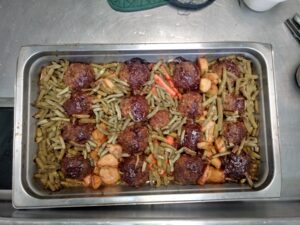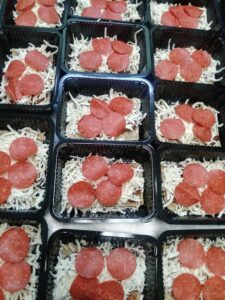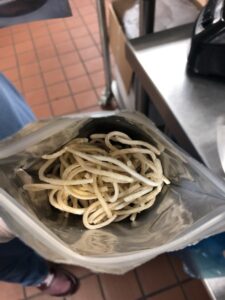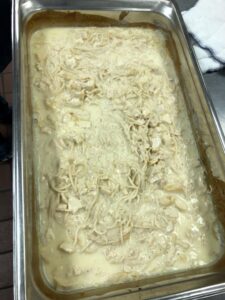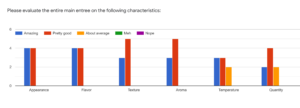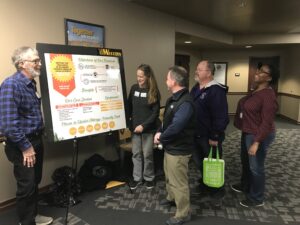Final report for FNC19-1175
Project Information
Pat & Rachel's Gardens LLC currently farms 13 acres in Johnson County Kansas. We grow a variety of vegetables, fruits, and herbs, and have been Certified Organic since 2014. In 2015 we added a certified, state licensed processing facility with walk-in coolers and freezer. Joining the Kansas City Food Hub in 2016, we became a subhub southwest of Kansas City where members' products could be aggregated for distribution. Our 2018 SARE Grant explored value-added processing and freezing for our own and our members' products.
Red Ridge Farms is a 3.5-acre certified organic farm in Odessa, MO owned by Jim and Ami Zumalt. They also manage a subhub for the Kansas City Food Hub, and operate a retail farmers market offering local produce, proteins, and gluten free and allergy friendly foods from their commercial kitchen. They have farmed for 9 years. Ami is the current Vice President of the KC Food Hub.
Kansas City Food Hub is a farmer-owned cooperative providing access to wholesale markets for members through sales, marketing, aggregation and distribution. The following member owners of Kansas City Food Hub are part of this project:
* Buller Family Farm, Lawrence KS. Certified organic 5 acre farm selling CSA, retail, and wholesale for 11 years. Owner/operator
Tom Buller is a founder and Treasurer of the KC Food Hub.
* JET Produce, Leavenworth, KS. 6 acre farm selling wholesale and retail for 4 years. Owner/operator Jacob Thomas is the secretary for the KC Food Hub.
Moon on the Meadow, Lawrence KS. Certified organic 5-acre farm selling CSA, retail, and wholesale for 11 years. Owner/operator Jill Elmers is a founder of the KCFood Hub.
* Green Thumbs Up, Lawrence, KS. A 3-acre retail and wholesale farm with 6 years experience. Partner/operator John Edmonds is a director for the KC Food Hub.
County Line Produce, El Dorado Springs, MO. A 32-acre farmer cooperative of 5 farms selling wholesale with 21 years experience.
* Boys Grow, Kansas City, MO. A 30-acre nonprofit mentoring urban youth through agricultural entrepreneurship, 9 years.
Lettuce Dream, Maryville, MO. A 4000 sq.Ft hydroponic farm. Charlie Clodfelter, creator, began Lettuce Dream in 2016 as a social enterprise to train and employ persons with cognitive or developmental disabilities.
Also:
* Moyer Farms, Richmond Mo,
* Larksmeadow Farm, Harrisonville, MO,
* Hicks Farm, Maryville MO,
* Limestone Gardens,
* Willow Tree Farms, Knob Noster, MO
Schools are struggling to meet dietary restrictions. Farms are struggling to achieve profitability; according to ATTRA $.17 of each food dollar supports a farmer, half of its 1980 value. There is a critical need for allergen-free meals, according to Warrensburg School Food Service Director, Heather Wirsig. There are 52 Warrensburg students with allergy restrictions; currently their meals are purchased from grocery stores. “Finding safe food for 1% of the school population is my biggest challenge,” stated Wirsig. As some of these students receive free or reduced price lunch, the district must provide safe meals- no matter the cost. We intend to create value-added products using farm fresh foods, in a category where farms could easily fill the demand. Within our farmer cooperative, we have allergy friendly commercial kitchens- both existing and planned.
Our 2018 SARE grant FNC18-1133 researched the mechanics of processing value-added foods safely. Building on that knowledge, Pat & Rachel's Gardens, in cooperation with KC Food Hub members, will research recipes demanded by institutions seeking specific allergen-free food. By using locally-grown products in a category where we can supply the need, we can help farms increase economic viability by improving the quality of life for people in our communities.
Introduction to the Report Our grant proposal had two main purposes, help local institutions struggling to provide allergen-free meals to their clients and to help local farmers by utilizing locally-grown produce, protein, and fruit to meet those institutional needs. We were familiar with the variety of locally-grown food from our involvement in the Kansas City Food Hub, a cooperative of sixteen farmers operating within 100 miles of Kansas City. Before writing our grant proposal, we were aware of the difficulties local school districts faced when trying to meet the nutritional needs of students with food allergies.
Our approach to this problem was to interview local school personnel in two of our closest school districts, Garner-Edgerton in Kansas and Warrensburg in Missouri. Although both districts had roughly the same number of students who were in need of special diets (roughly sixty in each district), each district requested help in a different way. Gardner-Edgerton focused on solving a specific problem. They couldn't figure out a way to make available the five commonly served pasta dishes since they did not have a gluten-free kitchen. Warrensburg presented a much more challenging problem to us--provide self-contained meals that could simply be heated and served without ever passing through their kitchens. Ami Zumalt worked with the Warrensburg district in Missouri while James Leek worked with Gardner-Edgerton. Ami's personal knowledge of making allergen-free meals helped her develop an extensive menu list along with a matrix showing ingredient contents. She also worked to incorporate locally-grown produce, protein, and fruit into these meals when it was economically possible. James's challenge was much simpler--provide the district with freeze-dried "nests" of gluten-free pasta that could be rehydrated and topped with the appropriate sauce for that menu item. Freeze drying technology became a central focus of James's research since there are few practitioners in this emerging technology working with local farmers and schools.
What follows in this report is a description of two case studies (Gardner-Edgerton, Kansas and Warrensburg, Missouri) describing the research process, what was done, the challenges that were faced, the methods employed, and the perennial difficulty of selling a product at a price that supports the farmers and is affordable to the buyer. We knew when we started that this project would be only a beginning and would just scratch the surface of the potential to meet a need that is also present in hospitals, nursing homes, daycare facilities, and individual homes. We set out to learn and to share what we learned.
- Identify crops products Kansas City Food Hub farmer/owners will have available for value-added allergy free meals.
- Identify needs in our local institutions for allergy-free menu items.
- Develop standardized recipes using available local products while researching
- Develop methodology for procuring best pricing for supplies and ingredients.
- Finalize recipes using fresh, processed, preserved, or frozen products.
- Make prototypes of products for sharing with institutions.
- Test the market for the value-added finished products, and potentially the recipes with their corresponding locally-grown products to institutions thereby increase viability of our farmer members.
- Share findings through the KC Food Hub website, annual meeting, and conferences.
Cooperators
- - Producer
- - Producer
- - Producer
Research
After speaking with local schools, we identified a problem we were equipped to solve. Institutions are struggling to find allergy friendly, healthy foods for students. Because we are small-scale farmers, we would struggle with providing value-added menu items for an entire school or institution population at a price they can afford, so the idea of solving a major problem for a small percentage of the population was born. Feeding community members with dietary food restrictions is a manageable subset of the larger population. Our steps for success:
-
Determine product availability from farmers
-
Brainstorm and research allergy-free products to create
-
Conduct market research with institutions to identify dietary restriction challenges and menu needs
-
Narrow focus to the most feasible recipes that we can reliably provide for most growing seasons
-
Create and trial initial recipes
-
Research packaging [with an emphasis on minimal waste], serving sizes, and preservation techniques best suited to deliver healthy, safe products
-
Calculate production cost; research options for purchasing supplies and non-local ingredients
-
Estimate margin
-
Determine serving size
-
Identify customers interested in our value-added menu of allergy-free local products
-
Verify all regulations have been met. Create methodology for each recipe ensuring products are allergy free [dairy, eggs, peanuts, tree nuts, fish, shellfish, soy, wheat] or free of any other required dietary restrictions
-
Create a value-added product label for each menu item meeting all institution, local, state, or federal regulations
-
Test products with potential customers
-
Scale recipes for potential volume; bulk purchase supplies to take fiscal advantage of any scaling up
-
Set pricing; confirm with buyers
-
Market and distribute final product
-
Assess project
For the Warrensburg Project:
-
Determine product availability from farmers: we had excess tomatoes, bell peppers, onion seconds, small potatoes, cabbage from storage, excess zucchini, ground beef, celery, parsley, cilantro, basil, and garlic.
-
Brainstorm and research allergy-free products to create: using the products we had, and also the requests from the school district, we created:
-
- Pizza: used our tomatoes, onions, peppers and herbs to create marinara with basil. Rest of ingredients were purchased.
-
- Egg Roll ins a Bowl: Chinese dish using local beef and local cabbage. Outsourced rest of ingredients.
- Other recipes still working on: beef pot pie, chicken pot pie, breakfast items, sandwiches, taco casserole
-
Conduct market research with institutions to identify dietary restriction- challenges and menu needs: met with Heather Wirsig of the Warrensburg school system April 2nd. They expressed enthusiasm for our project and encouraged me to research a piece of equipment from FormPlastics, a company specializing in creating tamper-proof food items in plastic and paperboard trays that can then be kept and served cold or reheated. They are mainly concerned with foods that allow the target audience to be served 'similar' foods to what the menu has- with an emphasis on quality foods that would be free from possible contamination- hoping to attract more of these students to eat at school, rather than bringing lunch from home. The main allergy categories are gluten-free and dairy, although they have students with each of the top allergens, including sesame. Some meals needed would be complete meals- they serve a chinese food option weekly- and it is full of allergens. Others- for instance pizza- would only need to be the entree. She is confident in her cafeterias' ability to safely prepare foods that naturally do not contain allergens. They serve several pasta options as well that would need to be substituted.
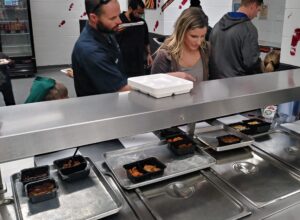
Parents participated in the market research too.
-
-
Heather invited us to a meeting of the Heart of America Alliance, a group of area food nutritionists who gather to discuss current topics. Alicia Ellingsworth also attended and spoke on behalf of the KC Food Hub. I spoke to the group about this SARE grant project and received good feedback from several interested schools who wanted follow up. Some were more concerned about price than others. One school said they would not be interested in food that could guarantee no contamination, because she did not want to give parents a false sense of security. She wants those kids to bring their own food.
-
-
Research packaging [with an emphasis on minimal waste], serving sizes, and preservation techniques best suited to deliver healthy safe products: we chose to go with Warrensburg's recommendation of a unit made by Form Plastics. We chose the simplest [cheapest] model to begin with. I can easily see a need for the bigger machine as we scale up, but this will get us started. For $3228, we received the sealing machine, the carton specific plates, and a box each of 3 different trays that will fit the plates.
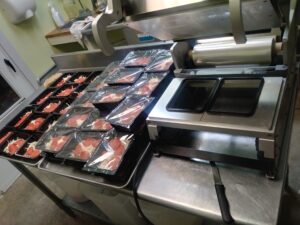
-
Calculate production cost; research options for purchasing supplies and non-local ingredients; Our goal on each food item was to have all expenses paid for including labor and overhead, with about a 20-30% margin built in. It was difficult to estimate accurately, as we are currently sourcing most ingredients in very small quantities, and labor will get cheaper as we make more meals at a time. Our menu items all tend to be about $4.50 each, with the hope that we can get that price down to $3.50 each as we increase quantity and source more products at bulk rates. We will never be able to completely compete on price--we want to source as much as possible locally, and our small farms set their prices where they need them to be. We instead want to focus on quality & safety of the food.
-
Determine serving size: serving size estimation is kind of a funny thing. Warrensburg kept telling us not to make them very big, and we kept making them too big. Students have such a small window of time to eat their lunch, it can't be a very big meal. Pizza slices are about 2.5" x 4.5", meat servings are about 3-4 ounces, and vegetable servings are about 1/3 cup.
-
Identify customers interested in our value-added menu of allergy-free local products: We identified several groups interested: schools, nursing homes, and daycares, for the most part. We have not reached out to hospitals yet. For this research project, we worked with 2 schools. Our facilities will need to expand to meet the need we are seeing in schools alone.
-
Test products with potential customers: we held a food tasting event with the Warrensburg school system. We received feedback that told us several of our dishes were ready for sales [meatloaf, pizza, chicken nuggets, eggroll in a bowl, sunbutter breakfast bars, pumpkin bread] and a few things need more work [pot pies, other desserts, lasagna]
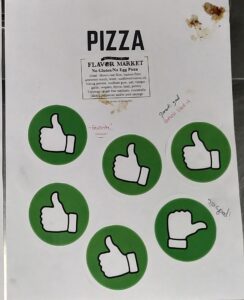
Most students gave our gluten-free pizza a thumbs up 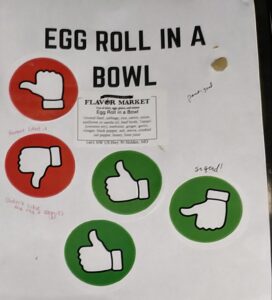
Mostly positive results from the egg roll tasting event
- Scale recipes for potential volume; bulk purchase supplies to take fiscal advantage of any scaling up: As we worked our way through this project, we have tried to price realistically based on our current expenses, with a 'nod' toward what our expenses reduce to when we have sales that allow us to purchase supplies in bulk.
- For canning jars: purchasing by the pallet from Arkansas Glass [870.932.4564] will be the most efficient way to secure jars. We will need to purchase at least 6 pallets of jars to realize good savings. Even 1 pallet is a better price than purchasing Ball or Kerr jars through retail sales outlets. We have canned thousands of jars using Arkansas Glass, with no perceived difference in sealing rates. Their jars are also smooth sided, which helps with labeling.
- Storage bags: we've gotten lucky and have found pallets and boxes of new unused food grade bags through local restaurant auction websites [there are several- one such site is www.Equipbid.com]. When we've needed a very specific size we buy from a few different vendors online, but one that consistently seems to have good bulk pricing is www.storesupply.com.
- Many of the vegetables we have needed for these recipes have come from our farm, where we can realize the entire value. That is not always feasible, and as we scale up, we will scale back in produce production, as it will be difficult to both grow and process the specialty crops. While we could do both if we hire the correct management teams, we struggle with finding qualified labor for our farm. We will source locally through the KCFoodHub, a farmer cooperative that will deliver to us, other local food suppliers such as Reinhart Foods, Sysco Foods, and Amish Communities where we can contract with families to provide bulk produce items.
- Storage boxes: In the Kansas City Area, there are several box companies. We have reached out to them and have gotten 'overrun' or 'misprint' boxes from other orders. These can be gotten significantly cheaper than ordering '#1" boxes. Again, we have also gotten clean, unused palleted boxes through auction sites. As we move forward with this project, we realize we will eventually need to purchase boxes when neither of these options are available, but so far this has helped us keep production costs down, and will continue to work for the foreseeable future. We also put plastic liners in the Arkansas Glass boxes, and reuse them. They are a perfect size for some of the frozen meals we are producing. Since they only had sterile glass jars in them, the plastic liner is a formality, as the boxes are clean. They also have minimal writing on them.
For the Gardner-Edgerton Project:
*Brainstorm and research allergy-free products needed:
Through the initial conversation with Ami Droegemeier at Gardner-Edgerton Schools, we discovered three potential products they needed: a gluten-free pasta, gluten-free dinner roll, and gluten-free cookies.
*Conduct market research with institutions to identify dietary restriction challenges and menu needs:
At the second interview with Ami Droegemeier at Gardner-Edgerton Schools, she requested only one product that would help their program serve the needs of students better. She requested a pasta “nest” that was gluten free so the cooks could start serving their six pasta dishes to those with gluten intolerance including:
*cold pasta salad
*spaghetti and meatballs
*chicken alfredo
*chicken parmesan
*mac and cheese
*Italian sausage bake
She requested that the noodles have no corn but that eggs were ok since only one student was egg intolerant. These pasta nests were to be freeze-dried so the staff only needed to add hot water from their hot water dispenser. The noodle we settled on was also egg free—a brown rice noodle.
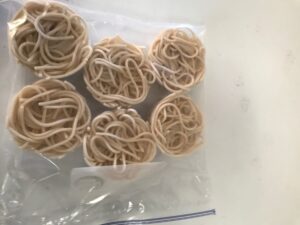
Our interview with Nancy Coughenour, Director of Food Services at Shawnee Mission Schools (28,000 students and 48 schools) showed no perceived needs at this time. They worked to solve the challenge of meeting dietary needs of students with food allergies in a five-pronged approach. First, offer many choices (four different entrees for elementary students, seven for middle school students, and nine entrees to choose from for high school students); second, communicate with parents so all menu items’ ingredient contents were readily available; third, maintain quality by continual taste testing by students; fourth decentralize food production so that each school had on-site preparation; and finally, thorough training of food service staff in coordination with that school’s nurse who communicated with parents.
*Research packaging, serving sizes, and preservation techniques best suited to deliver healthy, safe products: Each pasta nest was to be a one-cup serving when rehydrated. It was to be freeze-dried after it had been cooked. The local food service personnel would rehydrate and add the other ingredients made in the schools’ kitchens.
We conducted a taste test with Gardner-Edgerton High School students using the freeze-dried gluten-free and egg-free brown rice pasta. It was a smashing success. Ami Droegemeier, the Gardner-Edgerton Director of Nutrition Services wrote: "Our students definitely enjoyed the pasta option that we tested last week. I think you've hit on a winner! Preparation was very easy and we would likely purchase this item in bulk versus the individually-packaged units. Please let us know if you need any additional information."
Freeze-dried pasta ready for rehydration
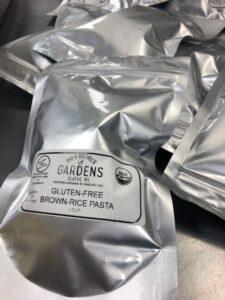 Pat & Rachels Gardens labels on mylar bags containing freeze-dried pasta
Pat & Rachels Gardens labels on mylar bags containing freeze-dried pasta
Rehydrated pasta added to chicken alfredo; the egg-intolerant student had spaghetti sauce added to the pasta.
Evaluation by students using the following criteria: Appearance, Flavor, Texture, Aroma, Temperature, Quality.
Blue: amazing; Red: pretty good; yellow: about average; green: Meh; magenta: nope
High School students who have suffered through dietary restrictions all their life tend to be critical, yet they were quite complimentary about the freeze-dried pasta we provided. They were asked the following: "Thinking just about the pasta in your dish, please let us know your thoughts compared to other gluten-free pasta you normally eat - be specific (better texture, too mushy, aftertaste, etc)!"
Here are their comments:
- It was one of the best gluten-free pastas I’ve ever had. It didn’t fall apart which is a big thing with gluten-free pasta!!
- I thought it had a really good texture and it wasn't dry or hard to chew. It was cooked really well so it wasn't too mushy or too hard.
- It was the best pasta I've had!
- It tasted a lot better
- It tasted similar to the pasta I eat, and I didn't think it was bad at all.
- It was very good and just like my other favorite pastas
- Compared to other kinds of gluten-free pasta I've eaten, this one was amazing! The texture of the pasta was nice, there was no apparent rice flavor in it (compared to other brands I've tried), and all around it felt, tasted, and looked like normal pasta. I'd say the pasta is perfectly fine as is!
- Much better than what I normally have.
Educational & Outreach Activities
Participation summary:
We held a Value-Added Workshop at our store on October 19th from 9 till 2. Twenty three people registered for the event. We discussed the SARE grant progress and gave a tour of our facility. It was well received as the last person left around 4 pm, after asking many questions about our startup experience. Different speakers used power point presentations to talk about food safety, value-added production on their farms, and processes for getting started.
We presented at the Great Plains Growers Conference in St. Joseph, Missouri on January 10.
We presented to the Farm to Fork Workshop in Osceola, Missouri February 11 where 150 attended.
Learning Outcomes
We learned there is an incredible need in this category- that of providing allergy-friendly foods to institutions, using local foods wherever possible. This has the potential of doubling our kitchen staff initially and allowing us to focus on LESS variety, but do more volume. It has been easy to talk with the schools, as they are eager to solve this problem. I would encourage others to explore this option in their communities, as it is a way for farmers to sell local, fresh products to institutions in a way that isn't just 'checking the box'. Schools really need these food items and they are eager to hear about the program.
Project Outcomes
An Amish farm near Windsor, MO is excited about supplying food items for this project. They have a daughter with down's syndrome, and another child with multiple food allergies, so they were eager to be a partner in providing the raw ingredients we use in the recipes. Since starting this project, we are also collaborating with them on the eggs needed to create a gluten free egg noodle. While not completely allergen free, this product would use the farmer's excess eggs and still help provide a need for people with gluten allergies and intolerance.
A beef farmer in Grain Valley, MO has been struggling with increasing sales, and will be supplying the beef for these menu items. While it may not be volume at first, it will also help get his name out, as we can market to our end users where the products came from.
Every summer we struggle with using all our tomato seconds. Now we immediately put all those seconds in a freezer so they will hold until we have time to thaw, chop and dice for marinara. The freezing process slips the skins off, which keeps the heat out of the kitchen [instead of boiling water baths]. We no longer are throwing hundreds of pounds of tomatoes on the compost pile.
We had practically no market returns to add to our compost pile this year. All were preserved and made into value-added products. Our sales from mid summer throughout the winter market we increased greatly. Value-added product accounted for 35% to 50% of sales each week!
We even had a person from New Jersey contact us. She was a recipient of our freeze-dried butternut squash as a gift. She liked it so much she order ten bags and paid the shipping.
Our frozen soups gave us the idea to freeze dry soups next year incorporating seconds, protein from other farmers, and veggies! They taste so good too when freeze dried.
This project needs to be expanded on. Up-sizing these meals for senior citizens is definitely one avenue to explore.
Also, there is a movement among childcare facilities to provide food 100% free of the top 8 allergens. This could be another avenue where the added bonus of the local food could be seen as a great option- and a great marketing tool for them with young parents seeking quality care for their children.
